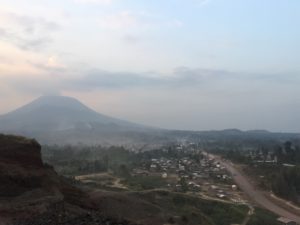
I am very grateful for the opportunity to study Swahili in DRC thanks to the SLA Grant and the Amani Language Initiative. Engaging with communities in Goma really helped elucidate not only the context and nuance in the language learning process but also provided a glimpse into local worldviews and meanings. I particularly enjoyed getting to know university students and volunteering at ULPGL exchanging ideas in French, English, and Swahili. I feel that I reached some of my language learning goals that I set out before the program in terms of identifying local idioms that are relevant to my research. However, one of the challenges I faced was distinguishing between Congolese Swahili and Kiswahili as well as slang Swahili and formal Swahili. It was especially hard for me as I had to juggle with French as well. I did not anticipate having to focus my attention on learning one language while needing to speak another depending on the setting.
I highly encourage the SLA study abroad experience. To learn a language the best thing one can do is to go to a country that speaks that language and immerse into the culture. I would suggest students to keep a language journal with them at all times. Having a journal where you can quickly jot down a word you don’t recognize or a song lyric that catches your attention could come in handy and expediate the learning process. I would also encourage students to live with people who don’t speak English so you can practice the language daily.
My summer language study abroad experience has been very useful, giving me an insider view into everyday life in Congo. My language learning experience helped facilitate cross-cultural communication and enabled me to build rapport with my interlocutors. The SLA grant and language skills I learned during this summer has built the foundation necessary for me to complete my dissertation research in the Great Lakes region of Africa. I intend to continue advancing my language fluency in Swahili by private lessons and independent study. I also look forward to continue taking classes at the Amani Language Initiative upon my return to Congo. Thanks to the generosity of the SLA grant, I am able to move forward with my doctoral research and career.
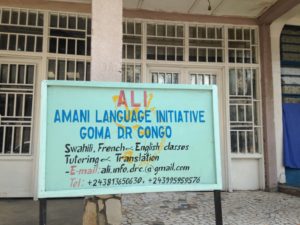
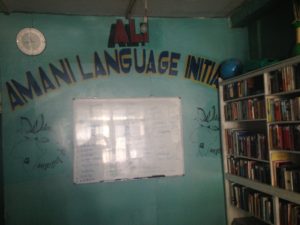 My first day in Swahili class at the Amani Language Initiative, Stewart and I had a good laugh. Well, mostly Stewart. As the founder of both the Amani Language Initiative, a training center that teaches Swahili, French, and English classes as well as the head of a non-governmental organization, Stewart had just won a Young African Leaders fellowship. As he told me about his award and travel plans, I congratulated him in Swahili by saying, “Hongera!” All of a sudden, Stewart burst out in uncontrollable laughter. I couldn’t understand what was so funny. After a few minutes, Stewart explained that hongera is a very formal Swahili term and he didn’t expect me to use it let alone know it. This was my first lesson in Swahili—the Kiswahili I had begun to learn the prior semester was completely different from Congolese Swahili.
My first day in Swahili class at the Amani Language Initiative, Stewart and I had a good laugh. Well, mostly Stewart. As the founder of both the Amani Language Initiative, a training center that teaches Swahili, French, and English classes as well as the head of a non-governmental organization, Stewart had just won a Young African Leaders fellowship. As he told me about his award and travel plans, I congratulated him in Swahili by saying, “Hongera!” All of a sudden, Stewart burst out in uncontrollable laughter. I couldn’t understand what was so funny. After a few minutes, Stewart explained that hongera is a very formal Swahili term and he didn’t expect me to use it let alone know it. This was my first lesson in Swahili—the Kiswahili I had begun to learn the prior semester was completely different from Congolese Swahili.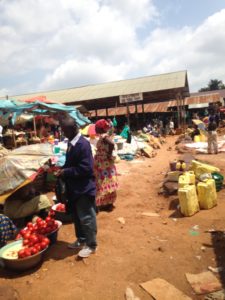
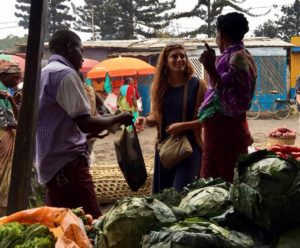

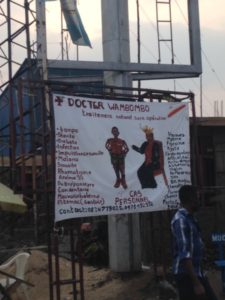

 rangers who protect the park, L’Institut Congolais pour la Conservation de la Nature (ICCN). One of the rangers lead our trek into the jungle the through dense green. After walking for about twenty minutes, we stopped to listen for the gorillas. We quickly switched directions and after trekking for five minutes, we came upon a group of gorillas basking and napping in the sun. The rangers told us that they had just finished a meal of fruits and leaves. The large silverback was cuddling with his children. It was the most profound experience because we were so close that we could look into their eyes and their gentleness. We sat and stared in awe of these majestic animals. Dominique looked over to me and said, “see how important conservation is?”
rangers who protect the park, L’Institut Congolais pour la Conservation de la Nature (ICCN). One of the rangers lead our trek into the jungle the through dense green. After walking for about twenty minutes, we stopped to listen for the gorillas. We quickly switched directions and after trekking for five minutes, we came upon a group of gorillas basking and napping in the sun. The rangers told us that they had just finished a meal of fruits and leaves. The large silverback was cuddling with his children. It was the most profound experience because we were so close that we could look into their eyes and their gentleness. We sat and stared in awe of these majestic animals. Dominique looked over to me and said, “see how important conservation is?”